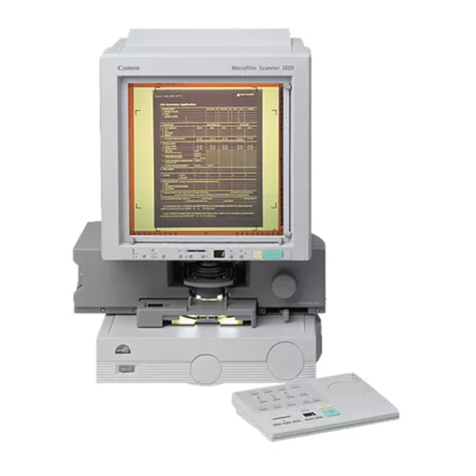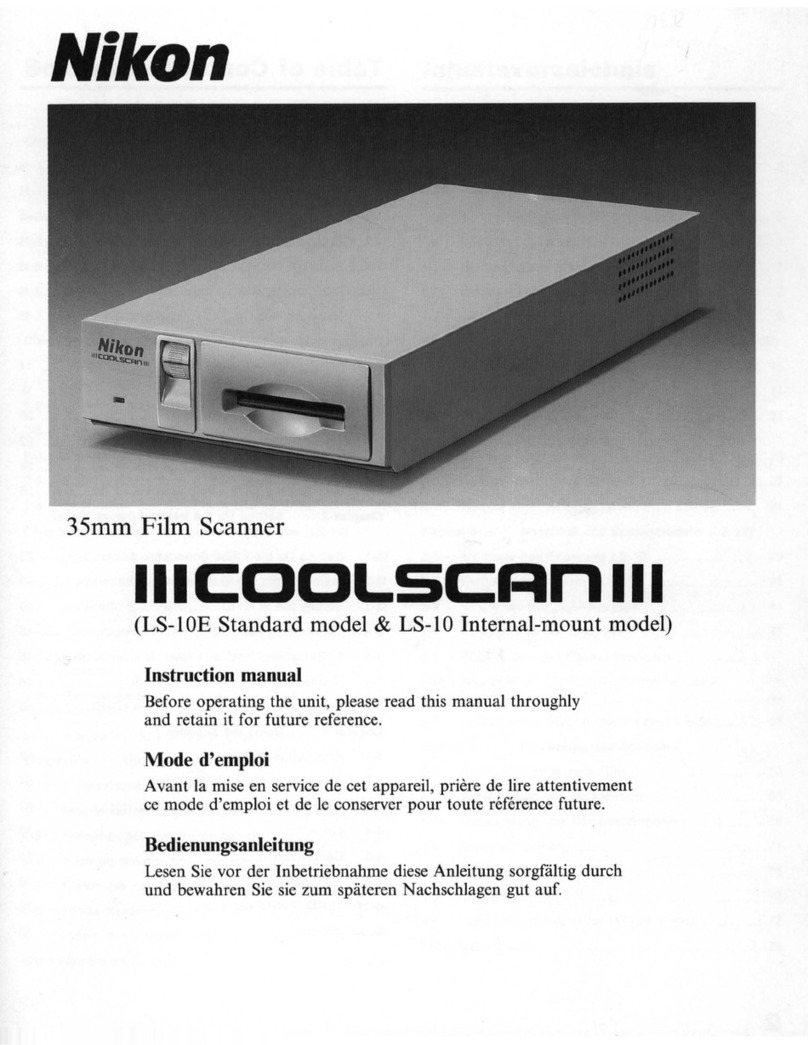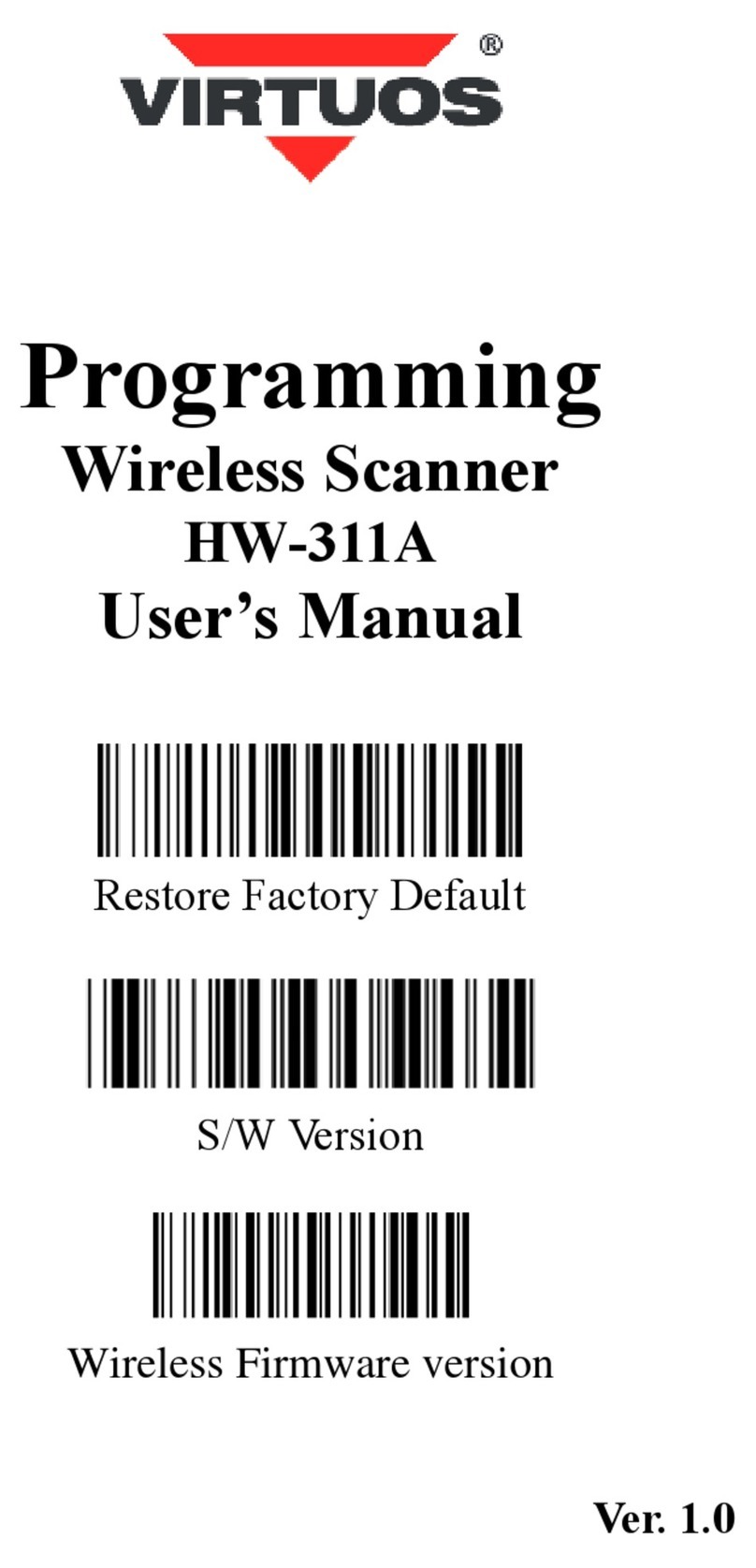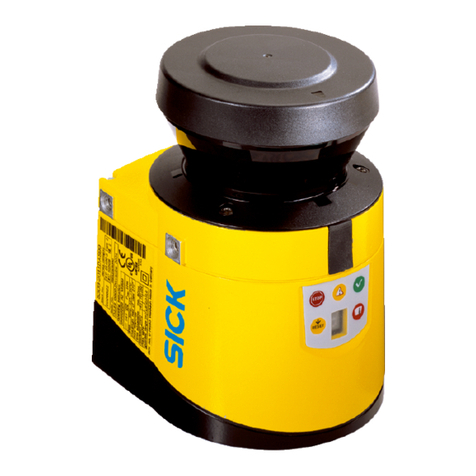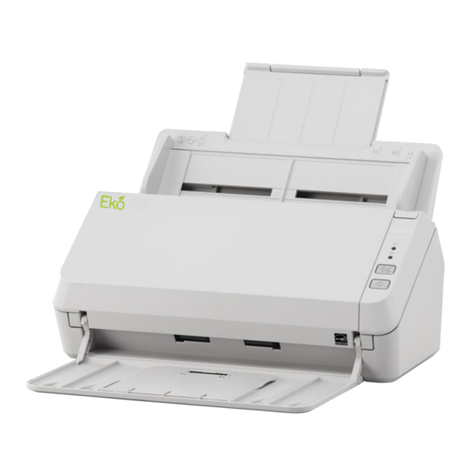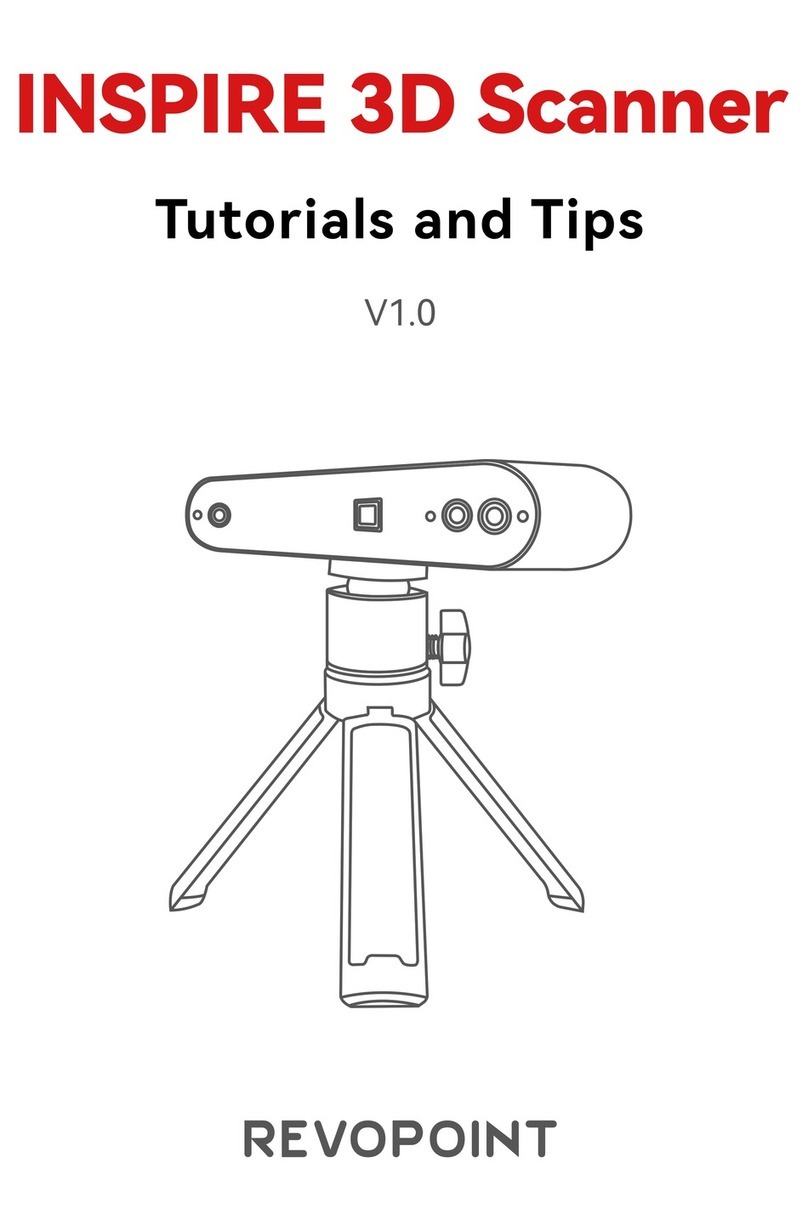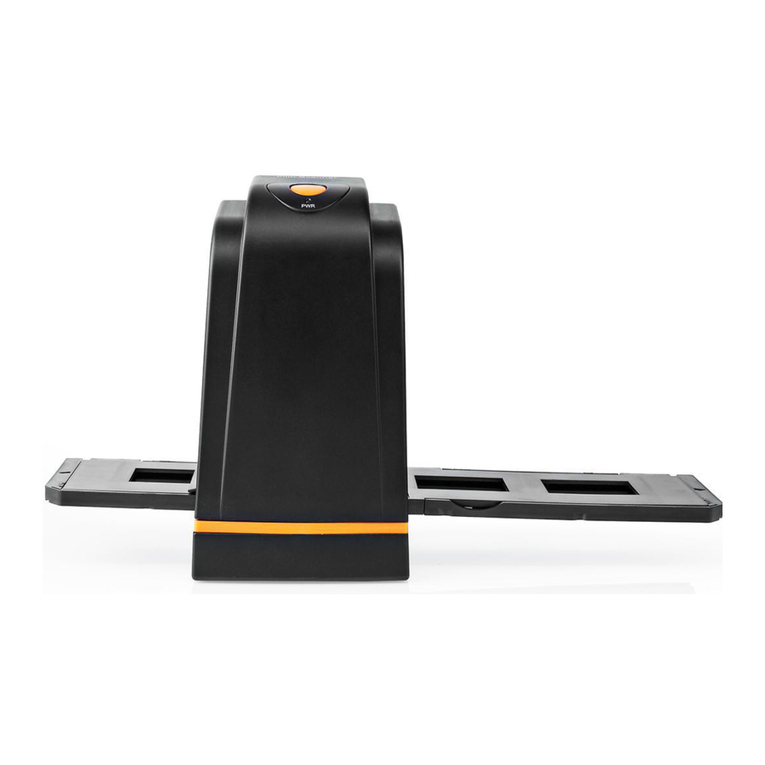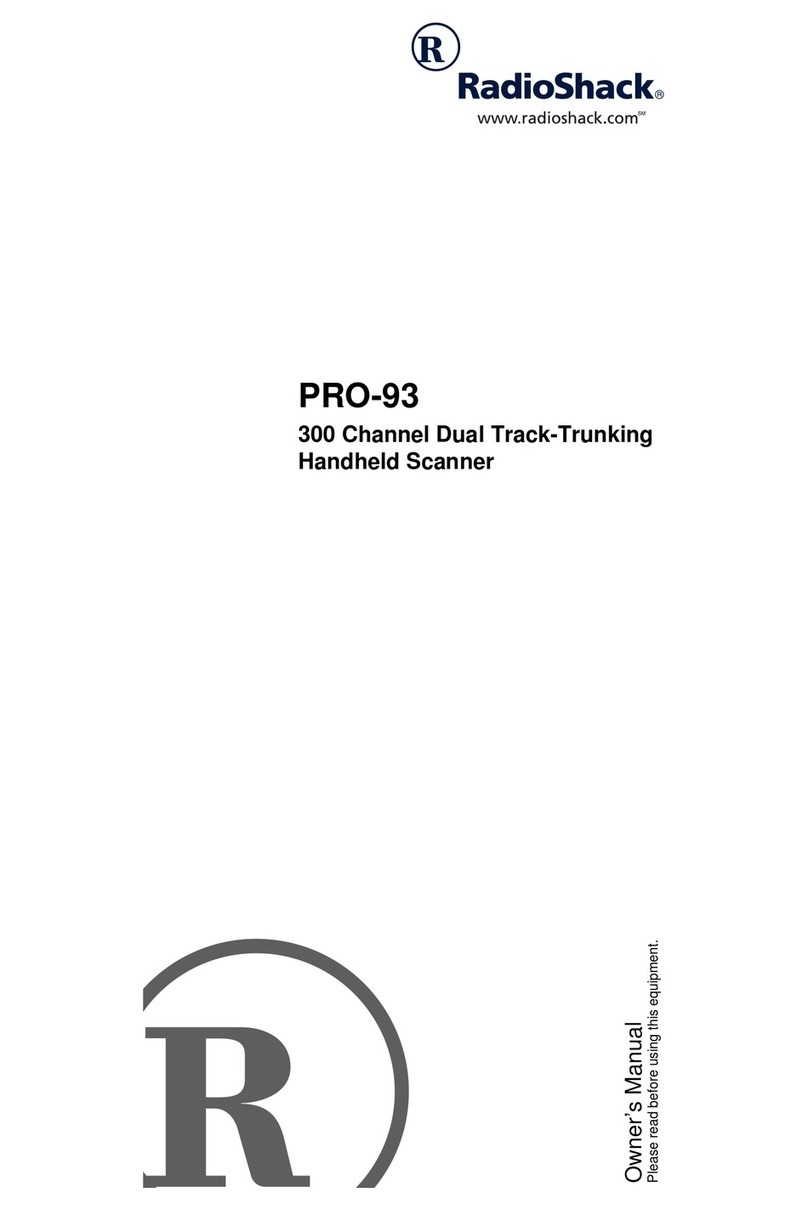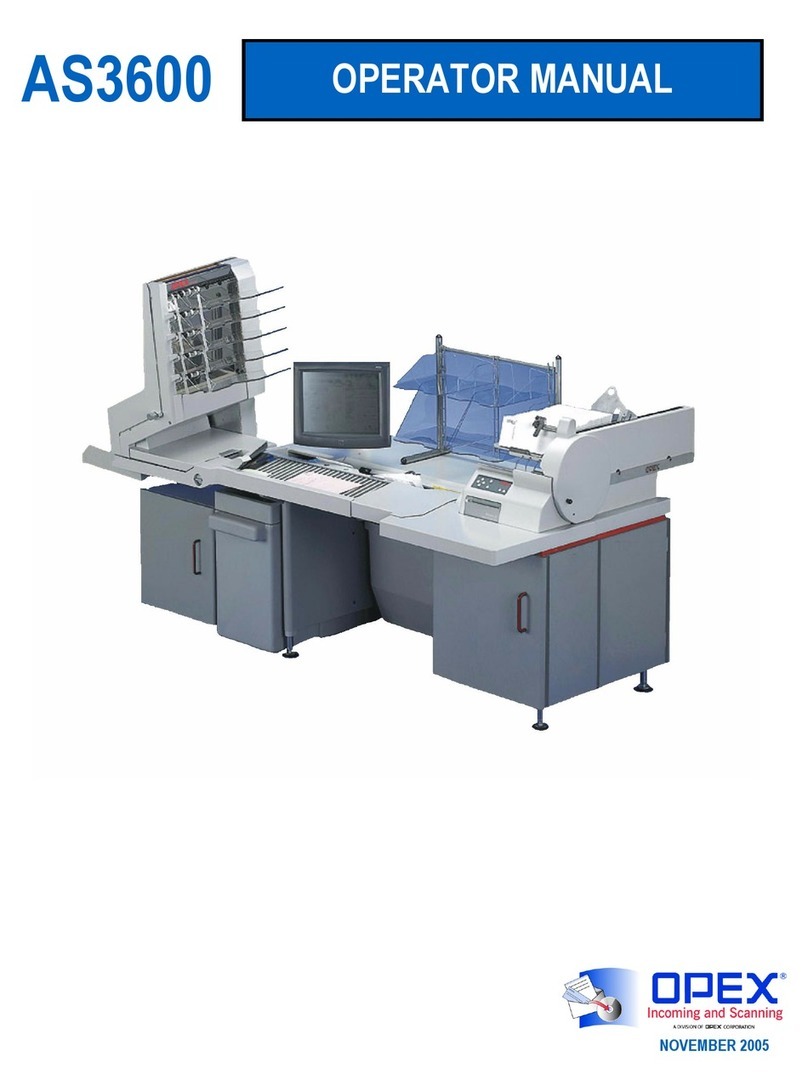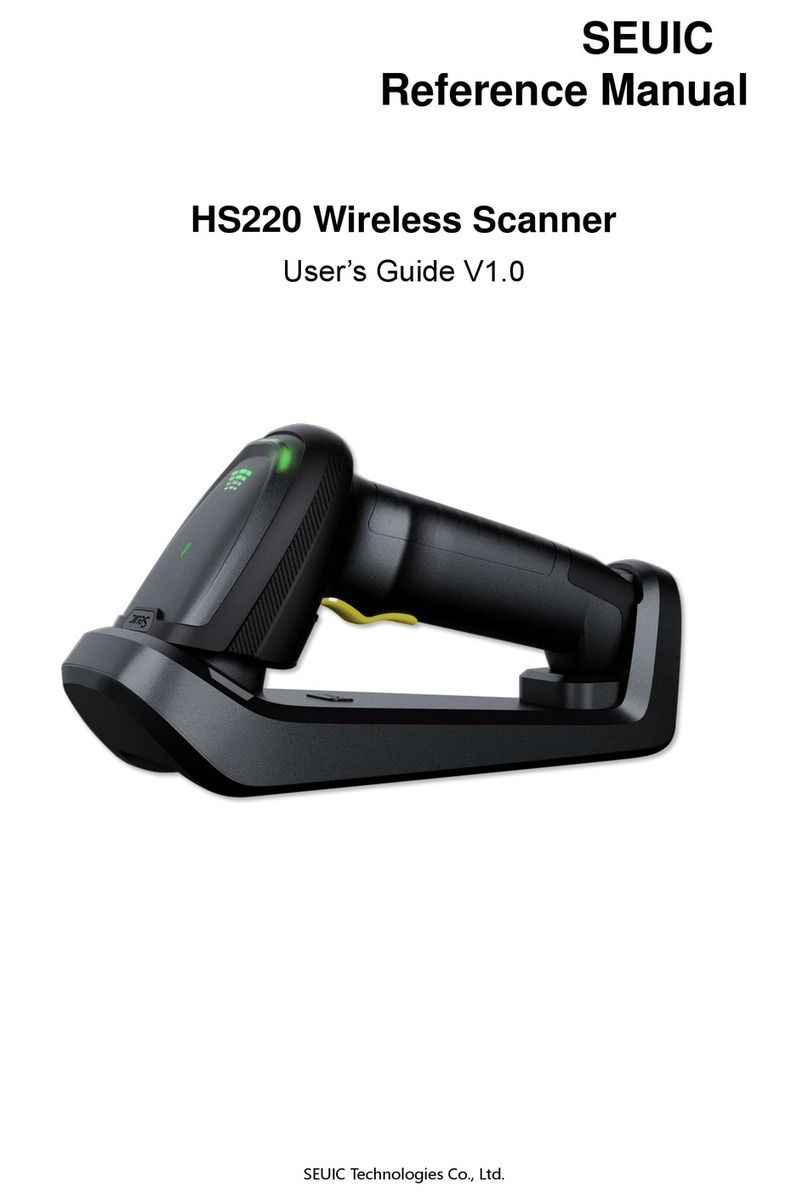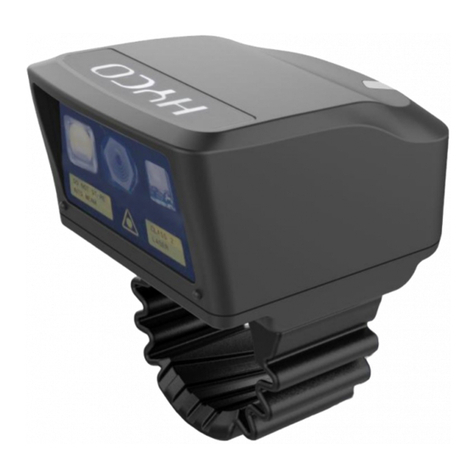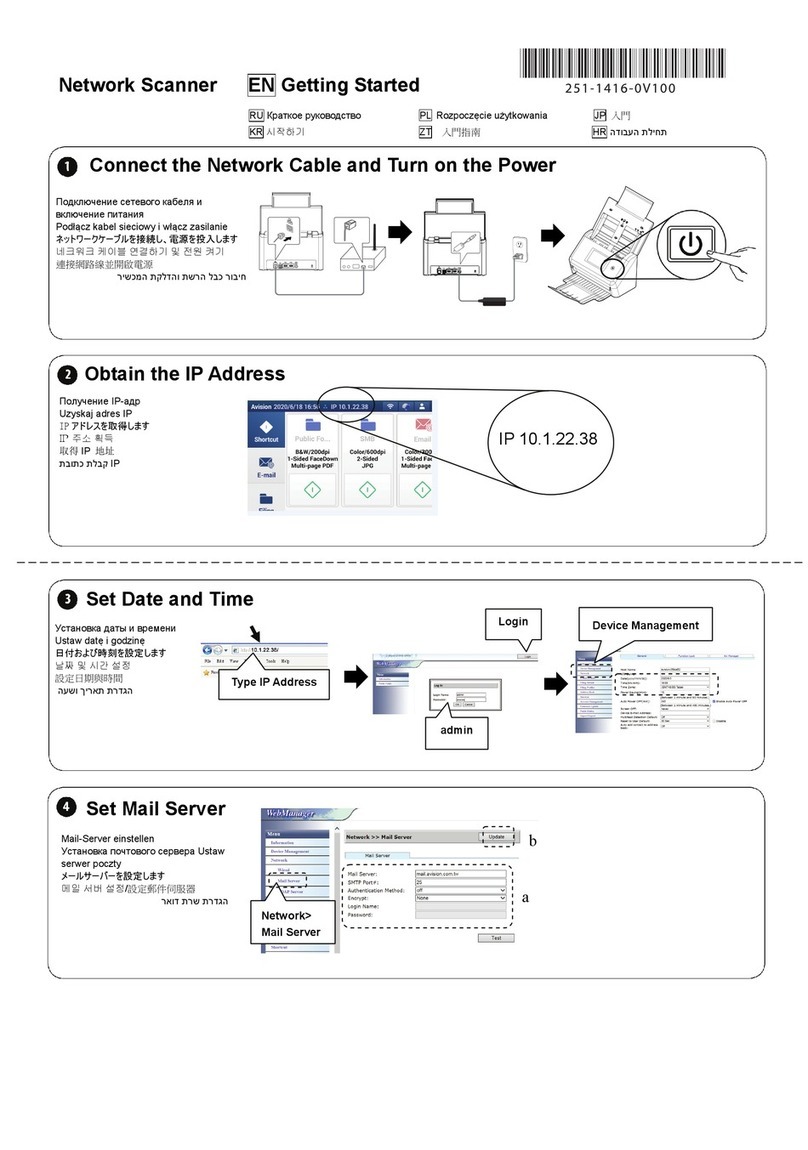Rockwell Automation AB Quality Allen-Bradley 1753-DNSI User manual

DeviceNet Safety
Scanner for
GuardPLC™
Controllers
Catalog Number 1753-DNSI
User Manual

Important User Information
Solid state equipment has operational characteristics differing from those of
electromechanical equipment. Safety Guidelines for the Application, Installation and
Maintenance of Solid State Controls (Publication SGI-1.1 available from your local
Rockwell Automation sales office or online at
http://www.ab.com/manuals/gi) describes some important differences
between solid state equipment and hard-wired electromechanical devices.
Because of this difference, and also because of the wide variety of uses for
solid state equipment, all persons responsible for applying this equipment
must satisfy themselves that each intended application of this equipment is
acceptable.
In no event will Rockwell Automation, Inc. be responsible or liable for
indirect or consequential damages resulting from the use or application of
this equipment.
The examples and diagrams in this manual are included solely for illustrative
purposes. Because of the many variables and requirements associated with
any particular installation, Rockwell Automation, Inc. cannot assume
responsibility or liability for actual use based on the examples and diagrams.
No patent liability is assumed by Rockwell Automation, Inc. with respect to
use of information, circuits, equipment, or software described in this manual.
Reproduction of the contents of this manual, in whole or in part, without
written permission of Rockwell Automation, Inc. is prohibited.
Throughout this manual, when necessary we use notes to make you aware of
safety considerations.
WARNING Identifies information about practices or circumstances
that can cause an explosion in a hazardous environment,
which may lead to personal injury or death, property
damage, or economic loss.
IMPORTANT Identifies information that is critical for successful
application and understanding of the product.
ATTENTION Identifies information about practices or circumstances
that can lead to personal injury or death, property
damage, or economic loss. Attentions help you:
•identify a hazard
•avoid a hazard
•recognize the consequence
SHOCK HAZARD Labels may be located on or inside the equipment (e.g.,
drive or motor) to alert people that dangerous voltage may
be present.
BURN HAZARD Labels may be located on or inside the equipment (e.g.,
drive or motor) to alert people that surfaces may be at
dangerous temperatures.

1Publication 1753-UM002A-EN-P - July 2005
Table of Contents
Preface
Who Should Use this Manual. . . . . . . . . . . . . . . . . . . . . . . P-1
Purpose of This Manual. . . . . . . . . . . . . . . . . . . . . . . . . . . P-1
Related Documentation . . . . . . . . . . . . . . . . . . . . . . . . . . . P-2
Common Techniques Used in This Manual. . . . . . . . . . . . . P-2
Understanding Terminology . . . . . . . . . . . . . . . . . . . . . . . P-3
Chapter 1
Before You Begin
Safety Concept . . . . . . . . . . . . . . . . . . . . . . . . . . . . . . . . . 1-1
DeviceNet Safety Scanner Communications . . . . . . . . . . . . 1-2
How the 1753-DNSI Communicates . . . . . . . . . . . . . . . 1-2
Understand Data Signals. . . . . . . . . . . . . . . . . . . . . . . . 1-3
How Data Tables Work . . . . . . . . . . . . . . . . . . . . . . . . 1-4
How to Distinguish Between Standard Data and Safety Data
in RSLogix Guard PLUS! . . . . . . . . . . . . . . . . . . . . . . . . 1-4
Role of RSNetWorx for DeviceNet and RSLogix Guard PLUS! 1-5
DeviceNet Safety Scanner Features. . . . . . . . . . . . . . . . . . . 1-6
Hardware Overview. . . . . . . . . . . . . . . . . . . . . . . . . . . 1-6
Supported Connections . . . . . . . . . . . . . . . . . . . . . . . . 1-7
Physical Layout of the DeviceNet Safety System . . . . . . . . . 1-8
DeviceNet Safety I/O Performance Factors . . . . . . . . . . 1-8
Choose a Communication Rate for the Network . . . . . . 1-9
Assign an Address to Each Device . . . . . . . . . . . . . . . . 1-10
Chapter 2
Install the 1753-DNSI
General Safety Information . . . . . . . . . . . . . . . . . . . . . . . . 2-1
Preventing Electrostatic Discharge . . . . . . . . . . . . . . . . 2-2
Mount the Scanner . . . . . . . . . . . . . . . . . . . . . . . . . . . . . . 2-2
DIN Rail Mounting. . . . . . . . . . . . . . . . . . . . . . . . . . . . 2-3
Panel Mounting . . . . . . . . . . . . . . . . . . . . . . . . . . . . . . 2-4
Ground the Scanner . . . . . . . . . . . . . . . . . . . . . . . . . . . . . 2-4
Connect Power Source . . . . . . . . . . . . . . . . . . . . . . . . . . . 2-5
Make Communication Connections . . . . . . . . . . . . . . . . . . 2-5
DeviceNet Connections . . . . . . . . . . . . . . . . . . . . . . . . 2-6
High-speed Safety Protocol (HSP) Connections . . . . . . . 2-7
Chapter 3
Set Up Your DeviceNet Network
Connect a Computer to the DeviceNet Network . . . . . . . . . 3-1
Configure a Driver for the Network . . . . . . . . . . . . . . . 3-1
Make Sure the Driver Works. . . . . . . . . . . . . . . . . . . . . 3-2
Commission All Nodes . . . . . . . . . . . . . . . . . . . . . . . . . . . 3-2
Browse the Network . . . . . . . . . . . . . . . . . . . . . . . . . . . . . 3-3
Safety Reset (Optional) . . . . . . . . . . . . . . . . . . . . . . . . . . . 3-4
Set Passwords (Optional). . . . . . . . . . . . . . . . . . . . . . . . . . 3-5
Set or Change a Password . . . . . . . . . . . . . . . . . . . . . . 3-5

Publication 1753-UM002A-EN-P - July 2005
Table of Contents 2
To set a password for a module: . . . . . . . . . . . . . . . . . 3-5
Forgotten Passwords . . . . . . . . . . . . . . . . . . . . . . . . . . 3-6
Chapter 4
Manage the Safety Network
Number
SNN Formats. . . . . . . . . . . . . . . . . . . . . . . . . . . . . . . . . . . 4-1
Time-based SNN (Recommended) . . . . . . . . . . . . . . . . 4-1
Manual SNN . . . . . . . . . . . . . . . . . . . . . . . . . . . . . . . . 4-2
Assignment of the SNN . . . . . . . . . . . . . . . . . . . . . . . . . . . 4-2
Automatic (Time-based) . . . . . . . . . . . . . . . . . . . . . . . . 4-2
Manual . . . . . . . . . . . . . . . . . . . . . . . . . . . . . . . . . . . . 4-3
Set the SNN in All Safety Nodes. . . . . . . . . . . . . . . . . . . . . 4-3
SNN Mismatch . . . . . . . . . . . . . . . . . . . . . . . . . . . . . . . . . 4-5
Safety Network Number Mismatch Dialog . . . . . . . . . . . 4-5
SNN and Node Address Changes . . . . . . . . . . . . . . . . . . . . 4-6
Chapter 5
Configure DeviceNet Nodes and
Connections
Configuration Signature. . . . . . . . . . . . . . . . . . . . . . . . . . . 5-1
Configure DeviceNet Safety I/O Target Nodes . . . . . . . . . . 5-2
1791DS DeviceNet Safety I/O Module Parameters . . . . . 5-2
Configure the DeviceNet Safety Scanner’s Safety
Connections . . . . . . . . . . . . . . . . . . . . . . . . . . . . . . . . . . . 5-3
Configure DeviceNet Standard Slave I/O Nodes . . . . . . . . . 5-6
Configure the DeviceNet Safety Scanner’s Standard
Connections . . . . . . . . . . . . . . . . . . . . . . . . . . . . . . . . . . . 5-6
Standard Communication Properties . . . . . . . . . . . . . . . 5-6
Create a Scanlist. . . . . . . . . . . . . . . . . . . . . . . . . . . . . . 5-8
Configure Standard Inputs . . . . . . . . . . . . . . . . . . . . . . 5-10
Configure Standard Outputs . . . . . . . . . . . . . . . . . . . . . 5-11
Configure GuardPLC Controller Settings . . . . . . . . . . . . . . . 5-12
Chapter 6
Create a GuardPLC Project with
High-Speed Safety Protocol
Create or Open a GuardPLC Project . . . . . . . . . . . . . . . . . 6-1
Add High-Speed Safety Protocol to the GuardPLC Controller
Resource. . . . . . . . . . . . . . . . . . . . . . . . . . . . . . . . . . . . . . 6-3
Review the GuardPLC Controller’s Communication Settings 6-5
Chapter 7
Associate the Scanner and
Controller and Download the
DeviceNet Network Configuration
Scanner Signals File. . . . . . . . . . . . . . . . . . . . . . . . . . . . . . 7-1
Target Connections File. . . . . . . . . . . . . . . . . . . . . . . . . . . 7-2
Automatically Update Signals. . . . . . . . . . . . . . . . . . . . . . . 7-2
Manually Associate the Scanner and Controller. . . . . . . . . . 7-4
Download the DeviceNet Network Configuration . . . . . . . . 7-5

Publication 1753-UM002A-EN-P - July 2005
Table of Contents 3
Chapter 8
Develop Your GuardPLC
Application
Define Signals for Your GuardPLC Application . . . . . . . . . . 8-1
Define Signals for Safety Data. . . . . . . . . . . . . . . . . . . . 8-1
Configure HSP Connection. . . . . . . . . . . . . . . . . . . . . . 8-3
Create Application Program Logic . . . . . . . . . . . . . . . . . . . 8-4
Save and Compile Application Logic . . . . . . . . . . . . . . . . . 8-4
Download the Project to the Controller . . . . . . . . . . . . . . . 8-4
Place the Controller in Stop Mode (if necessary) . . . . . . 8-4
Download the Project . . . . . . . . . . . . . . . . . . . . . . . . . 8-4
Chapter 9
Verify Your DeviceNet Safety
Configuration
Start the Safety Device Verification Wizard . . . . . . . . . . . . . 9-1
Determine if Devices Can Be Verified . . . . . . . . . . . . . . . . 9-1
Select Devices to Verify. . . . . . . . . . . . . . . . . . . . . . . . . . . 9-3
Review the Safety Device Verification Reports . . . . . . . . . . 9-5
Lock Safety Devices . . . . . . . . . . . . . . . . . . . . . . . . . . . . . 9-6
View the Safety Device Verification Wizard Summary . . . . . 9-7
Chapter 10
Monitor Status
LED Status Indicators. . . . . . . . . . . . . . . . . . . . . . . . . . . . . 10-1
Alphanumeric Display . . . . . . . . . . . . . . . . . . . . . . . . . . . . 10-2
At Power Up . . . . . . . . . . . . . . . . . . . . . . . . . . . . . . . . 10-2
During Operation . . . . . . . . . . . . . . . . . . . . . . . . . . . . 10-2
Connection Status . . . . . . . . . . . . . . . . . . . . . . . . . . . . . . . 10-9
DeviceNet Connection Status Bit Behavior . . . . . . . . . . 10-9
DeviceNet Safety Connection Status . . . . . . . . . . . . . . 10-10
Standard DeviceNet Connection Status . . . . . . . . . . . . 10-11
DeviceNet Interface Status . . . . . . . . . . . . . . . . . . . . . 10-12
Appendix A
Specifications
General . . . . . . . . . . . . . . . . . . . . . . . . . . . . . . . . . . . . . . A-1
Environmental . . . . . . . . . . . . . . . . . . . . . . . . . . . . . . . . . A-1
Electrical/EMC . . . . . . . . . . . . . . . . . . . . . . . . . . . . . . . . . A-2
Certifications. . . . . . . . . . . . . . . . . . . . . . . . . . . . . . . . . . . A-3
Appendix B
ConfigurePeer-to-PeerDeviceNet
Communications
Plan Your Peer-to-Peer Communications . . . . . . . . . . . . . . B-2
Commission a Peer Scanner. . . . . . . . . . . . . . . . . . . . . . . . B-2
Add a Peer Controller . . . . . . . . . . . . . . . . . . . . . . . . . . . . B-3
Define Target Connections for Standard and Safety Data. . . B-4
Create Required Signals . . . . . . . . . . . . . . . . . . . . . . . . B-5
Define Standard Target Connections . . . . . . . . . . . . . . . B-6
Define Safety Connections . . . . . . . . . . . . . . . . . . . . . . B-7
Configure Peer-to-Peer Connections. . . . . . . . . . . . . . . . . . B-8

Publication 1753-UM002A-EN-P - July 2005
Table of Contents 4
Associate the Peer Safety Scanner and GuardPLC
Controller . . . . . . . . . . . . . . . . . . . . . . . . . . . . . . . . . . B-8
Add the Peer Scanner to the Scanlist. . . . . . . . . . . . . . . B-9
Configure Safety Connections. . . . . . . . . . . . . . . . . . . B-10
Appendix C
DeviceNet Class Codes
DeviceNet Object . . . . . . . . . . . . . . . . . . . . . . . . . . . . . . . C-1
Identity Object . . . . . . . . . . . . . . . . . . . . . . . . . . . . . . . . . C-1
Safety Supervisor Object . . . . . . . . . . . . . . . . . . . . . . . . . . C-1
Appendix D
Calculate Safety Connection
Bandwidth
Single-cast Inputs . . . . . . . . . . . . . . . . . . . . . . . . . . . . . . . D-1
1 to 2 Bytes . . . . . . . . . . . . . . . . . . . . . . . . . . . . . . . . . D-1
3 to 250 Bytes . . . . . . . . . . . . . . . . . . . . . . . . . . . . . . . D-1
Single-cast Outputs . . . . . . . . . . . . . . . . . . . . . . . . . . . . . . D-2
1 to 2 Bytes . . . . . . . . . . . . . . . . . . . . . . . . . . . . . . . . . D-2
3 to 250 Bytes . . . . . . . . . . . . . . . . . . . . . . . . . . . . . . . D-2
Multicast Connections . . . . . . . . . . . . . . . . . . . . . . . . . . . . D-2
1 to 2 Bytes . . . . . . . . . . . . . . . . . . . . . . . . . . . . . . . . . D-2
3 to 250 Bytes . . . . . . . . . . . . . . . . . . . . . . . . . . . . . . . D-3
Glossary
Index

1Publication 1753-UM002A-EN-P - July 2005
Preface
Read this preface to familiarize yourself with the rest of the manual. It
provides information concerning:
•who should use this manual
•the purpose of this manual
•related documentation
•common techniques used in this manual
•terminology used in this manual
Who Should Use this
Manual
Use this manual if you are responsible for designing, installing,
programming, or troubleshooting a safety control system that includes
a GuardPLC controller communicating on a DeviceNet Safety network
through a 1753-DNSI module.
We assume that you:
•have a basic understanding of electrical circuitry
•are trained and experienced in the creation, operation, and
maintenance of safety systems.
•know each of your device’s I/O parameters and requirements.
Purpose of This Manual
This manual only briefly describes the safety concept of the DeviceNet
Safety Scanner for GuardPLC Controllers. Its purpose is to provide
information on installing, operating, and maintaining your 1753-DNSI
in a GuardPLC controller system.
For detailed information on safety system requirements regarding the
DeviceNet Safety Scanner for GuardPLC Controllers, refer to the
GuardPLC Controller Systems Safety Reference Manual, publication
number 1753-RM002.

Publication 1753-UM002A-EN-P - July 2005
2 Preface
Related Documentation
The table below provides a listing of publications that contain
important information about GuardPLC Controller systems.
If you would like a manual, you can:
•download a free electronic version from the internet at
www.rockwellautomation.com/literature.
•purchase a printed manual by contacting your local
Allen-Bradley distributor or Rockwell Automation sales office.
Common Techniques Used
in This Manual
The following conventions are used throughout this manual:
•Bulleted lists, such as this one, provide information, not
procedural steps.
•Numbered lists provide sequential steps or hierarchical
information.
For Read this document Publication
Information on installing, programming, operating, and
troubleshooting a GuardPLC Controller
GuardPLC Controller User Manual 1753-UM001
Detailed requirements for achieving and maintaining SIL 3
applications with the GuardPLC Controller System
GuardPLC Controller Systems Safety Reference Manual 1753-RM002
Information on installing the DeviceNet Safety Scanner for
GuardPLC Controllers
DeviceNet Safety Scanner for GuardPLC Installation
Instructions
1753-IN009
Information on installing DeviceNet Safety I/O Modules DeviceNet Safety I/O Installation Instructions 1791DS-IN001
Information on configuration and programming for DeviceNet
Safety I/O Modules
DeviceNet Safety I/O User Manual 1791DS-UM001

Publication 1753-UM002A-EN-P - July 2005
Preface 3
Understanding Terminology
The following table defines acronyms used in this manual.
Acronym: Full Term: Definition:
1oo2 One Out of Two A safety architecture consisting of two channels connected in parallel, such
that either channel can perform the safety function.
CAN Controller Area Network The networking standard that defines the physical layer of DeviceNet.
COS Change of State A type of I/O data communication in which the interface module can send and
receive data with slave devices whenever a data change occurs in the
configured slave device.
EDS Electronic Data Sheet A vendor-supplied template that specifies how device configuration
information is displayed as well as what is an appropriate entry (value).
EPR Expected Packet Rate The rate at which packets are expected to be received by a device.
HSP High-Speed Safety Protocol A high-speed, high-integrity protocol designed to transfer both safety and
standard data between the GuardPLC controller and the DeviceNet Safety
Scanner for GuardPLC Controllers.
MAC ID Media Access Identifier The network address of a DeviceNet node.
MTBF Mean Time Between Failures Average time between failure occurrences.
MTTR Mean Time to Restoration Average time needed to restore normal operation after a failure has occurred.
PC Personal Computer Computer used to interface with, and control, a controller-based system via
programming software.
PFD Probability of Failure on Demand The average probability of a system to fail to perform its design function on
demand.
PFH Probability of Failure per Hour The probability of a system to have a dangerous failure occur per hour.
Rx Receive —
SNN Safety Network Number A unique number that identifies a safety network, or safety sub-net, across all
networks in the safety system.
Tx Transmit —

Publication 1753-UM002A-EN-P - July 2005
4 Preface

1Publication 1753-UM002A-EN-P - July 2005
Chapter
1
Before You Begin
This chapter provides an overview of communication between the
1753-DNSI and the GuardPLC controller. Before configuring your
1753-DNSI module, you must understand:
•the safety concept of the system
•the data exchange between the GuardPLC controller and
DeviceNet devices through the 1753-DNSI module
•the roles of RSNetWorx for DeviceNet and RSLogix Guard PLUS!
software in the safety system
•the features of the DeviceNet Safety Scanner
•the physical layout of your network
Safety Concept
The DeviceNet Safety Scanner for GuardPLC Controllers is certified for
use in GuardPLC safety applications up to and including Safety
Integrity Level (SIL) 3, according to IEC 61508, and Category (CAT) 4,
according to EN 954-1, in which the de-energized state is the safety
state.
The DeviceNet Safety Scanner and the GuardPLC system use the
following mechanisms to support the integrity of the data they
exchange:
•Safety Network Number – A unique number that identifies the
Safety Network. Each DeviceNet sub-network that contains
safety nodes must have one unique Safety Network Number.
•Configuration Signature – The combination of an ID number,
date, and time that uniquely identifies a specific configuration
for a safety device.
IMPORTANT For SIL 3 and CAT 4 safety system requirements,
including proof test intervals, system reaction time,
and PFD/PFH calculations, refer to the GuardPLC
Controller Systems Safety Reference Manual,
publication number 1753-RM002. You must read,
understand, and fulfill these requirements prior to
operating a GuardPLC controller-based SIL 3 or CAT
4 safety system.

Publication 1753-UM002A-EN-P - July 2005
1-2 Before You Begin
•HSP (High-speed Safety Protocol) Signature – This is a
read-only value that represents the data exchanged between the
GuardPLC controller and the safety scanner. The HSP Signature
is calculated based on the Scanner Configuration Signature and
changes only when the data exchanged by the controller and
the safety scanner changes. The HSP Signature is sent to the
controller configuration software and helps ensure the integrity
of the data.
•Controller ID (SRS) – A unique identifier for every GuardPLC
controller and GuardPLC Ethernet Distributed I/O module in a
system, the Controller ID must be a unique number from 1 to
65,535. The default is 60000.
•Safety-Lock – The safety scanner and DeviceNet safety I/O
modules must be Safety-Locked to prevent their configurations
from being unintentionally modified. Safety-Lock all DeviceNet
Safety devices by running the Safety Device Verification Wizard
in RSNetWorx for DeviceNet before placing the safety
application into service.
•Password protection – The configuration of the safety scanner
can be protected by the use of an optional password. If you set
a password in a safety device, the download, Safety-Reset,
Safety-Lock and Safety-Unlock operations will require a
password.
DeviceNet Safety Scanner
Communications
The 1753-DNSI provides DeviceNet access for GuardPLC 1600 and
GuardPLC 1800 controllers. These GuardPLC controllers support
communications via High-Speed Safety Protocol (HSP). The
1753-DNSI reads and writes data from DeviceNet nodes and
exchanges this aggregate data with the GuardPLC controller via HSP.
The 1753-DNSI scanner communicates with DeviceNet devices over
the network to:
•read inputs from a device
•write outputs to a device
•monitor device status
How the 1753-DNSI Communicates
For standard data, the safety scanner communicates with a device
via strobe, poll, change of state, and/or cyclic messages. It uses these
messages to solicit data from or deliver data to each device in its
scanlist.

Publication 1753-UM002A-EN-P - July 2005
Before You Begin 1-3
For safety data, the scanner communicates with safety devices via
cyclic messages only. You configure input and output connections in
the DeviceNet safety scanner to transfer input and output data to and
from DeviceNet safety I/O modules and the GuardPLC controller.
The scanner can make data available to other DeviceNet scanners
using Target connections. When Target connections are enabled, the
safety scanner looks like a standard I/O device that can be added to
another scanner’s scanlist,or a safety target device allowing another
safety scanner to connect to the safety data by adding a safety
connection. This allows for the transfer of data signals between two
GuardPLC controllers for safety interlocking and distributed safety
control. Standard data signals can also be exchanged with PLCs, HMIs,
or a ControlLogix system with a 1756-DNB scanner on the DeviceNet
network. For more information on Target connections, see
Appendix B.
Understand Data Signals
In order to understand how to use data signals from the safety scanner
in your GuardPLC application logic, you must know:
•whether the signal data is regarded as safety or standard data in
the end device, and
•whether the signal data was transferred over a safety connection
or a standard connection.
The following table defines permitted uses of safety and standard
signals based on connection and signal type.
End Device Signal
Definition Connection Type Permitted Use in Application
Safety Safety Safety
Standard Standard
Standard Safety Standard
Standard Standard
IMPORTANT Only safety signal data transmitted over safety
connections may be used as safety data in safety
application logic.

Publication 1753-UM002A-EN-P - July 2005
1-4 Before You Begin
How Data Tables Work
To exchange data, the GuardPLC controller and the 1753-DNSI use
two pairs of data tables: one pair for safety input and output data and
one pair for standard input and output data.
Standard DeviceNet Explicit Messaging connections are limited to
read-only access to safety data.
How to Distinguish Between Standard Data and Safety Data in
RSLogix Guard PLUS!
In the HSP Signal Connection dialogs (in RSLogix Guard PLUS!),
signals that are transferred over safety connections are shown in white
text on a red background. Signals transferred over a standard
connection are shown in blue text on a gray background.
Connection Type Scanner Inputs Scanner Outputs
Safety
Scanner is the
originator.
Data the scanner reads from
its target nodes. The data
layout is defined by the
target node’s configuration.
Data the scanner writes to
its target nodes. The data
layout is defined by the
target node’s configuration.
Scanner is the
target.
Data that one other CIP
Safety originator may write
on the scanner’s target
output connection point. The
data signals to be written
are selected in RSLogix
Guard PLUS!.
Data that one or more other
CIP Safety originators may
read from the scanner’s
target input connection
point. The data signals to be
read are selected in RSLogix
Guard PLUS!.
Standard
Scanner is the
master.
Data the scanner reads from
its standard DeviceNet
slaves. The data layout is
defined by the target node’s
configuration.
Data the scanner writes to
its standard DeviceNet
slaves. The data layout is
defined by the target node’s
configuration.
Scanner is the
slave.
Data that one other
standard DeviceNet master
can write on the scanner’s
slave mode outputs. The
data signals are selected in
RSLogix Guard PLUS!.
Data that one or more other
standard DeviceNet master
can read from the scanner’s
slave mode inputs. The data
signals are selected in
RSLogix Guard PLUS!.
ATTENTION To maintain the safety integrity level (SIL) of your
system, you must ensure that safety data read by
Explicit Messaging is used only as standard data in
your application.

Publication 1753-UM002A-EN-P - July 2005
Before You Begin 1-5
Since this colorization only applies to the Connect Signals dialogs
available from the HSP protocol context menu, we strongly
recommend that when using both standard and safety signals in your
application, you use a naming convention to visually distinguish
between standard and safety signals throughout the RSLogix Guard
PLUS! programming environment. For example, use a prefix of ‘std_’
for any signals that are standard and a prefix of ‘safe_’ for any signals
that are safety-related.
Role of RSNetWorx for
DeviceNet and RSLogix
Guard PLUS!
RSNetWorx for DeviceNet, version 6.x or higher, is the configuration
tool for the 1753-DNSI on the DeviceNet Safety network. RSNetWorx
for DeviceNet can connect to the safety scanner directly over the
DeviceNet network via an RS-232 interface (1770-KFD module) or PC
card (1784-PCD or -PCID) or through another network using a bridge
device. A bridge can be either a single device with communication
ports for two different networks, or separate communication devices
in the same chassis.
RSNetWorx for DeviceNet exchanges signal information with RSLogix
Guard PLUS!, the configuration and programming tool for the
GuardPLC controller. The Scanner Signals and Target Connections
IMPORTANT The red/blue colorization is not a guarantee that a
signal is a safety signal. It only indicates which type
of connection the signal was transferred over. The
classification of the end node must also be
considered. Any signal that appears in the (blue)
standard Connect Signals window and is regarded as
safety at the end device must be treated as standard
in your application. Any signal that appears in the
(red) safety Connect Signals window and is regarded
as standard at the end device must be treated as
standard in your application. In order for a signal to
be regarded as a safety value in your application, the
end device configuration must treat it as safety and it
must be transferred over a DeviceNet Safety
connection.
L+ L-
24V dc
123456
1234
1L-
L-L- L+ L+
L-DO 2
(2A)
34
1LS+- LS+ LS+ LS+ LS+L-
D1
234
56
13 14 15 16 17 18
5L-
D1
678
19 20 21 22 23 24
9L-
D1
1011 12
25 26 27 28 29 30
13 L-
D1
1415 16
31 32 33 34 35 36
17 L-
D1
1819 20
37 38 39 40 41 42
19 20 21 22 23 2413 14 15 16 23 24 2526 27 28 29 30 31 32 33 34 35 36 37 38 39 40 41 42
789101112
78910
5L- L-DO 6
(2A)
7 8
11 12
COMM3
ASCII/HSP
RS-485
24VDC
COMM2 COMM1
RUN
24V DC
GuardPLCEthernet
10/100BaseT
PROG
ERROR
FAULT
FORCE
BL
OSL
PROFIBUS
3
(—)
4
(—)
3
(—)
4
(—)
1753-L28BBBM
20DC Inputs
8DC Outputs
DeviceNet
PC with RSNetWorx for
DeviceNet Software PC with RSLogix Guard
PLUS! Software
1770-KFD PC
Communication
Module
GuardPLC Controller
1753-DNSI

Publication 1753-UM002A-EN-P - July 2005
1-6 Before You Begin
Files enable RSNetWorx for DeviceNet and RSLogix Guard PLUS! to
share the same view of the individual signals available on all of the
DeviceNet connections present in a specific DeviceNet Safety Scanner
configuration.
The following table lists the software and revision level required to
operate with the 1753-DNSI scanner.
DeviceNet Safety Scanner
Features
Hardware Overview
TIP If you install RSLogix Guard PLUS! and RSNetWorx
for DeviceNet on the same PC, you can take
advantage of the ‘Automatically Update Signals’
feature. Otherwise, you must manually import and
export the Scanner Signals and Target Connections
files. See Chapter 7, Associate the Scanner and
Controller and Download the DeviceNet Network
Configuration, for more information.
Function Software Revision
Communications RSLinx 2.42 or higher
DeviceNet Configuration RSNetWorx for DeviceNet 6.x or higher
Programming Application Logic
RSLogix Guard PLUS!,
Program Management
4.0 or higher
RSLogix Guard PLUS!,
Hardware Management
6.x or higher
Front View Bottom View
DeviceNet Safety Port
HSP Port
character display
LED Indicators

Publication 1753-UM002A-EN-P - July 2005
Before You Begin 1-7
The 1753-DNSI features two communication ports; one for DeviceNet
communications and one for High-Speed Safety Protocol (HSP)
communication with a GuardPLC controller. The HSP port is a 1 Mbps,
full-duplex RS-485 interface.
The safety scanner also features a 4-character dot-matrix display,
which provides status and error codes. Status LEDs on the safety
scanner indicate module, network, and HSP connection status. See
Chapter 10 for more information.
Supported Connections
The DeviceNet Safety port supports a maximum of 32 DeviceNet
Safety input connections, 32 DeviceNet Safety output connections,
and standard connections for up to 63 nodes.
The safety scanner does not support Quick Connect, Auto Device
Replacement or Autoscan.
Safety Connections
The safety scanner supports single-cast producing or consuming
connections and multi-cast consuming connections as a DeviceNet
Safety originator. Up to 32 producing and 32 consuming safety
connections can be made. These connections are used when the
safety scanner is communicating to distributed safety I/O modules.
The safety scanner also supports the use of two safety targets, defined
by RSLogix Guard PLUS! and made available via the Target
Connections File. One target may be a single- or multi-cast producer,
the other may be a single-cast consumer. These connections allow the
safety scanner to look like safety I/O to another safety scanner on the
network, and can be used for interlocking of safety data between two
GuardPLC systems.
Standard Connections
The safety scanner supports the following standard DeviceNet
connection types:
Standard Master Connections Standard Slave Connections
Polled Polled
Change of State (COS) —
Cyclic —
Bit Strobe —

Publication 1753-UM002A-EN-P - July 2005
1-8 Before You Begin
Communication Rate
The safety scanner supports the following communication rates, but
does not support autobaud:
•125 Kbps (default)
•250 Kbps
•500 Kbps
Physical Layout of the
DeviceNet Safety System
Planning your system helps ensure that you can:
•meet safety times
•use memory and bandwidth efficiently
•fulfill device-specific requirements
•leave room for system expansion
Before configuring your 1753-DNSI scanner, you should be familiar
with each of the DeviceNet devices on your network. You should
know each device’s:
•system safety time requirements
•communication requirements
•I/O size
•frequency of message delivery
You must also understand and define which data elements can be
treated as safety and which as standard in your intended
configuration.
DeviceNet Safety I/O Performance Factors
Safety nodes have priority on a DeviceNet network, but the
performance of DeviceNet Safety I/O modules can be affected by the:
•baud rate of the network (Lower baud rates mean slower
transmissions and slower responses.)
•packet size for the various connections (Bigger packets may
result in fragmented messages and slower responses than
single-packet messages, but use fewer resources.)
•type and number of connections used (Using point-to-point
connections to make multiple connections to an input node uses
more resources than a multicast connection.)
•RPI of the devices (Lower RPIs consume more bandwidth but
lower system reaction time.)

Publication 1753-UM002A-EN-P - July 2005
Before You Begin 1-9
Choose a Communication Rate for the Network
The default communication rate for a DeviceNet network is
125K bit/s. This is the easiest communication rate to use.
If you choose to use a different communication rate, the length of the
trunkline and type of cable determine which communication rates
your application can support.
Set the baud rate of the DeviceNet Safety Scanner using the Node
Commissioning tool in RSNetWorx for DeviceNet. See Commission All
Nodes on page 3-2.
The following table lists the most common methods for setting
communication rates for other DeviceNet devices.
Communication
Rate
Maximum Distance CumulativeDrop
Line Length
flat cable thick cable thin cable
125K bit/s 420 m (1378 ft) 500 m (1640 ft) 100 m (328 ft) 156 m (512 ft)
250K bit/s 200 m (656 ft) 250 m (820 ft) 100 m (328 ft) 78 m (256 ft)
500K bit/s 75 m (246 ft) 100 m (328 ft) 100 m (328 ft) 39 m (128 ft)
IMPORTANT If you change the communication rate of your
network, make sure that all devices change to the
new communication rate. Mixed communication
rates produce communication errors.
Method Description
autobaud At power up, the device automatically sets its communication
rate to the baud rate of the first device it finds on the network.
The device remains set until it powers up again.
The network requires at least one device with a fixed
communication rate so that the autobaud devices have something
against which to set. Typically, scanners and network interfaces
have a fixed communication rate.
switches or
pushbuttons on the
device
Some devices have switches or a pushbutton that sets the
communication rate. Typically, the switch or pushbutton lets you
select either autobaud or a fixed communication rate (125K, 250K,
or 500K bit/s). The device reads the switch setting at power up. If
you change the setting, you must cycle power for the change to
take effect.
software Some devices require a programming device to set its address
and communication rate. For example, you can use the Node
Commissioning tool in RSNetWorx for DeviceNet to set the
communication rate of a device.

Publication 1753-UM002A-EN-P - July 2005
1-10 Before You Begin
Assign an Address to Each Device
To communicate on the DeviceNet network, each device requires its
own address. Follow the recommendations below when assigning
addresses to the devices on your network.
Standard DeviceNet assigns communication priority based on the
device’s node number. The lower the node number, the higher the
device’s communications priority. This priority becomes important
when multiple nodes are trying to communicate on the network at the
same time.
DeviceNet Safety nodes have additional priority on the network,
regardless of node number. DeviceNet Safety communications from
devices with lower node numbers have priority over DeviceNet Safety
communications from devices with higher node numbers.
Give this device This address Notes
scanner 0 If you have multiple scanners, give them
the lowest addresses in sequence.
any device on your network,
except the scanner
1 to 61 Gaps between addresses are allowed
and have no effect on system
performance. Leaving gaps gives you
more flexibility as you develop your
system.
RSNetWorx for DeviceNet
workstation
62 If you connect a computer directly to the
DeviceNet network, use address 62 for
the computer or bridging/linking device.
no device 63 Leave address 63 open. This is where a
non-commissioned node typically enters
the network.
Table of contents
Other Rockwell Automation Scanner manuals
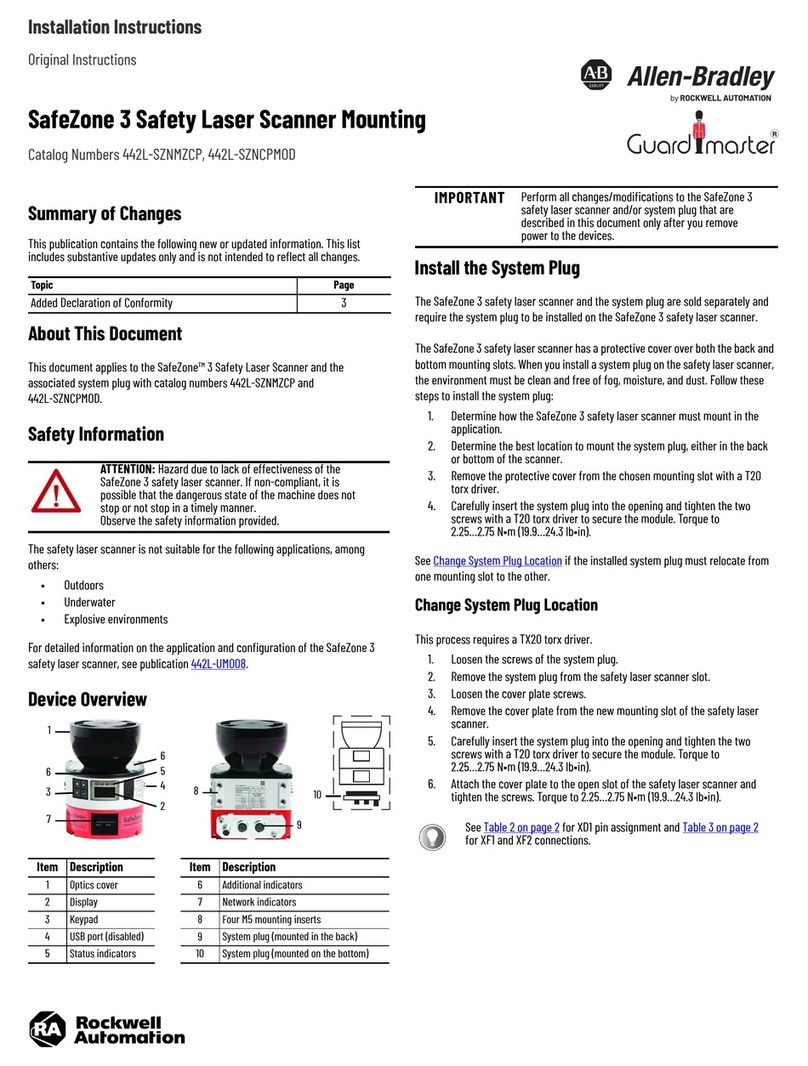
Rockwell Automation
Rockwell Automation Allen-Bradley Guardmaster SafeZone 3 User manual
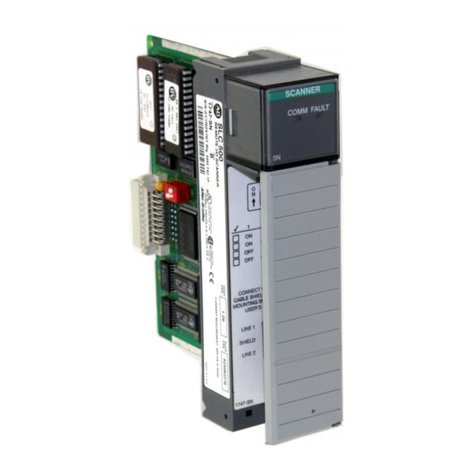
Rockwell Automation
Rockwell Automation Allen-Bradley 1747-SN User manual

Rockwell Automation
Rockwell Automation 40072-107-01 User manual
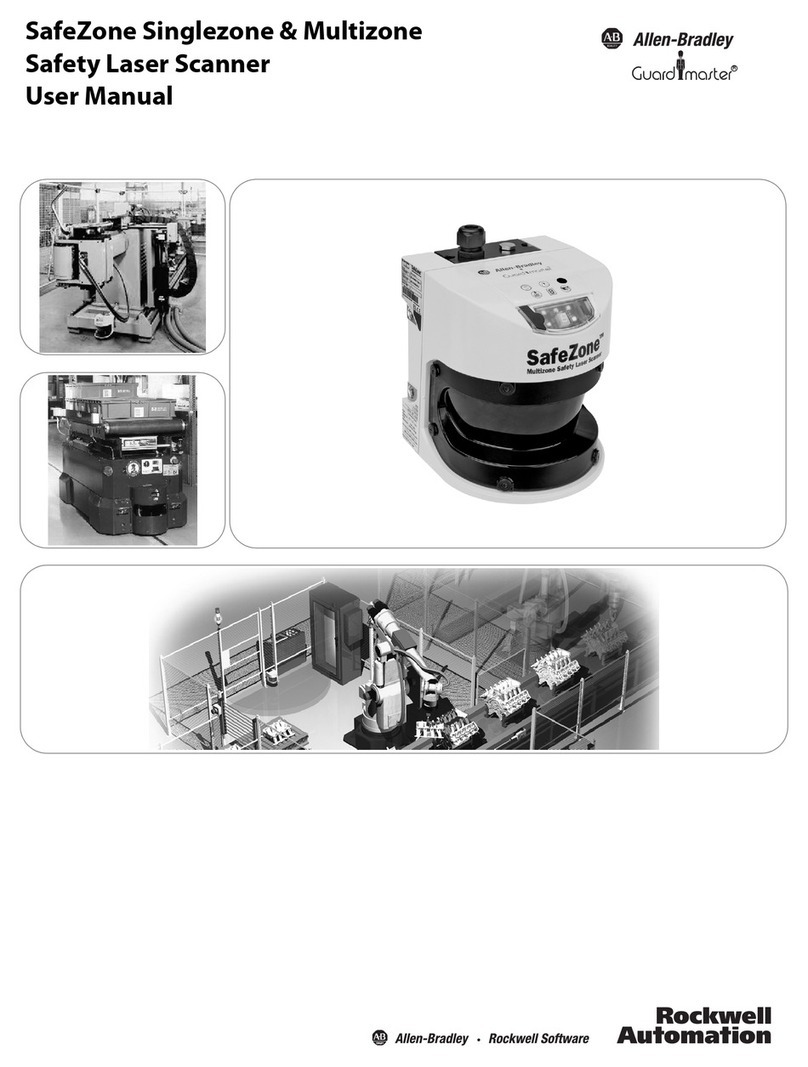
Rockwell Automation
Rockwell Automation Allen-Bradley Guard Master SafeZone User manual
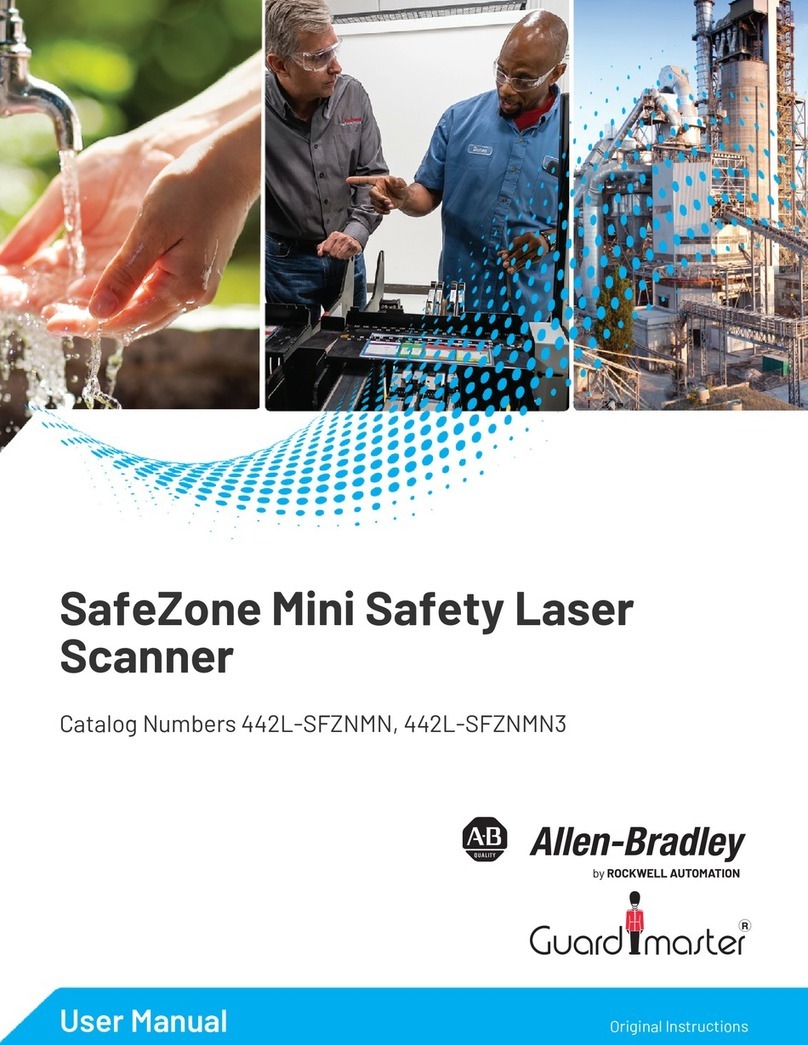
Rockwell Automation
Rockwell Automation Allen-Bradley SafeZone Mini User manual



